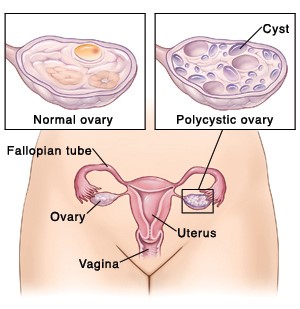General Introduction
Polycystic ovary syndrome is a common hormone disorder that affects women of reproductive age. The effects can begin straight after menarche, while for some in response to weight gain. Basically it is a collection of problems that are found together and not all women have all the same symptoms. Diagnosis is made once the patient has any of these two problems: lack of ovulation substantial (anovulation), high testosterone (male hormone) levels (hyperandrogenism) and multiple small cysts located along the outer edge of ovary (polycystic).
Signs and Symptoms
The presentation can vary from person to person, in both type and severity. Commonest problem encountered is menstrual abnormality such as prolonged interval in between menses, failure to menstruate and prolonged scanty or heavy periods. Excess facial/body hair, acne and male-pattern baldness reflects excess androgen, however these signs vary with each ethnic group. In some the inability to become pregnant may be the first sign. Ultrasound examination especially done via the vagina might show enlarged ovaries containing multiple small cysts.
 Source: http://www.fairview.org/healthlibrary/Article/89567
Source: http://www.fairview.org/healthlibrary/Article/89567
Causes and complication
The exact cause is still unknown but certain factors may play a role. These include insulin resistance resulting in excess insulin production. It is felt that the excess insulin could boost androgen production in the ovaries. There could to be hereditary link among female family members.
Having polycystic ovarian syndrome (PCOS) can increase the risk of long-term complications such as type 2 diabetes and heart disease especially if obesity is also present.
Treatment and medication
At this moment there is no cure for PCOS however different treatment options can alleviate symptoms of this disease including infertility. The advised treatment option is a healthy lifestyle with ideal body weight.
The medical options include:
- In treatment of infertility ovulation induction drugs such as clomiphene citrate drugs, FSH injections and occasionally surgical ovarian drilling.
- In menstrual irregularities medications like cyclical hormonal pills such as birth control pills are used.
- Specific medical treatment is given where there is either acne, excess body hair or male-pattern baldness.
- Insulin-sensitizing medications are used when high levels of insulin is present.







